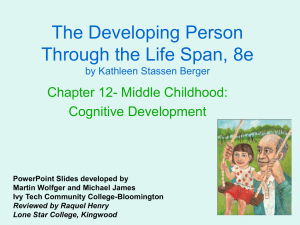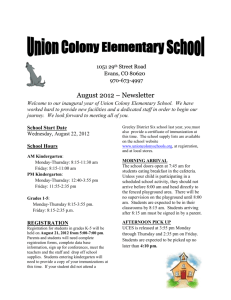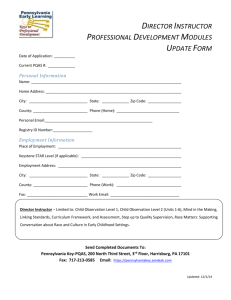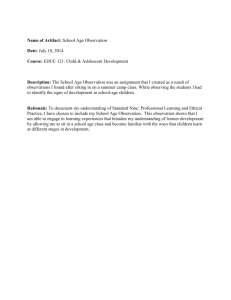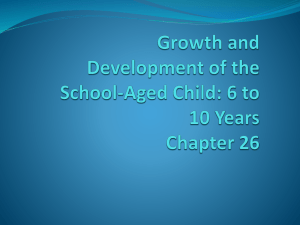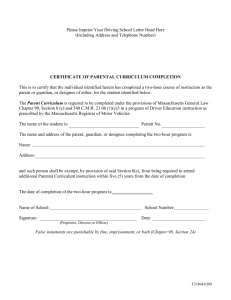Standards for Public School Operated School
advertisement
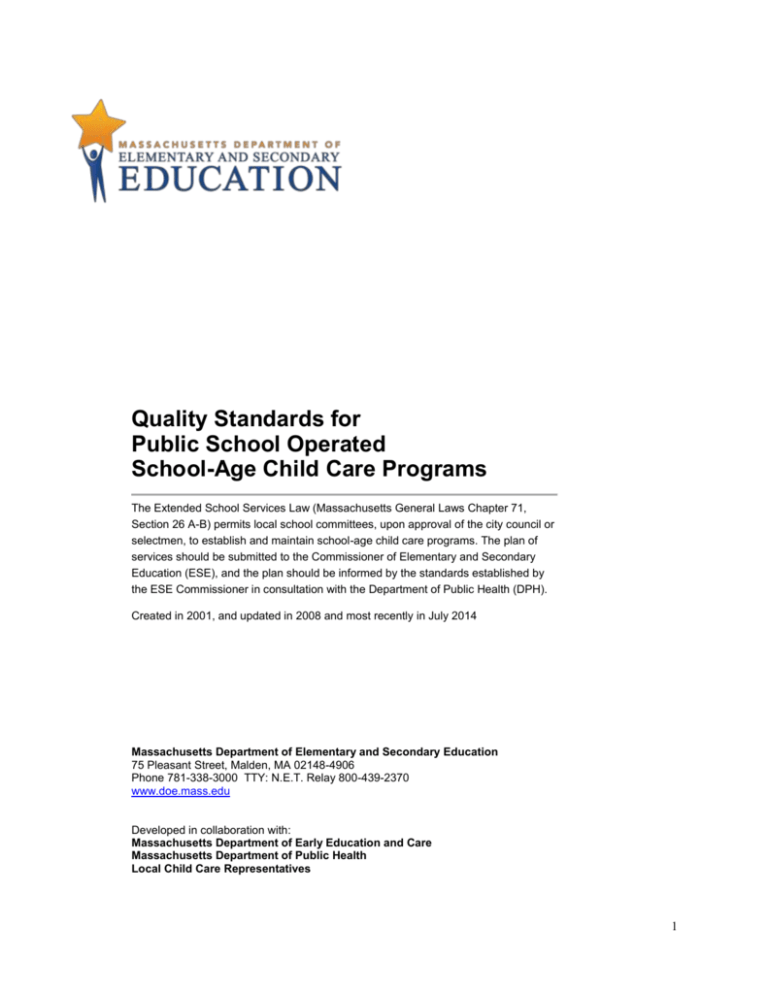
Quality Standards for Public School Operated School-Age Child Care Programs The Extended School Services Law (Massachusetts General Laws Chapter 71, Section 26 A-B) permits local school committees, upon approval of the city council or selectmen, to establish and maintain school-age child care programs. The plan of services should be submitted to the Commissioner of Elementary and Secondary Education (ESE), and the plan should be informed by the standards established by the ESE Commissioner in consultation with the Department of Public Health (DPH). Created in 2001, and updated in 2008 and most recently in July 2014 Massachusetts Department of Elementary and Secondary Education 75 Pleasant Street, Malden, MA 02148-4906 Phone 781-338-3000 TTY: N.E.T. Relay 800-439-2370 www.doe.mass.edu Developed in collaboration with: Massachusetts Department of Early Education and Care Massachusetts Department of Public Health Local Child Care Representatives 1 This document was prepared by the Massachusetts Department of Elementary and Secondary Education Mitchell D. Chester, Ed.D. Commissioner The Massachusetts Department of Elementary and Secondary Education, an affirmative action employer, is committed to ensuring that all of its programs and facilities are accessible to all members of the public. We do not discriminate on the basis of age, color, disability, national origin, race, religion, sex, gender identity, or sexual orientation. Inquiries regarding the Department’s compliance with Title IX and other civil rights laws may be directed to the Human Resources Director, 75 Pleasant St., Malden, MA 02148-4906. Phone: 781-338-6105. © 2014 Massachusetts Department of Elementary and Secondary Education Permission is hereby granted to copy any or all parts of this document for non-commercial educational purposes. Please credit the “Massachusetts Department of Elementary and Secondary Education.” This document printed on recycled paper Massachusetts Department of Elementary and Secondary Education 75 Pleasant Street, Malden, MA 02148-4906 Phone 781-338-3000 TTY: N.E.T. Relay 800-439-2370 www.doe.mass.edu 2 Table of Contents Introduction ................................................................................................................... 1 Registration/Program Approval Procedures .............................................................. 2 Checklist of Quality Indicators for Public School Operated School-Age Child Care Programs ....................................................................................................................... 3 Standards for Public School Operated School-Age Child Care Programs .............. 5 SECTION 1. INTERACTIONS AMONG STAFF AND CHILDREN ................................. 6 SECTION 2. ACTIVITIES/EXPERIENCES ..................................................................... 7 SECTION 3. INTERACTIONS AMONG STAFF AND FAMILY ...................................... 8 SECTION 4. ADMINISTRATION .................................................................................... 9 SECTION 5. STAFFING ............................................................................................... 12 SECTION 6. INDOOR AND OUTDOOR PHYSICAL ENVIRONMENT......................... 15 SECTION 7. HEALTH AND SAFETY ........................................................................... 17 SECTION 8. NUTRITION AND FOOD SERVICE ......................................................... 20 SECTION 9. TRANSPORTATION ................................................................................ 21 SECTION 10. EVALUATION ........................................................................................ 22 Appendix A: Definition of Terms................................................................................ 23 3 Introduction A variety of societal changes affecting children and families have increased the need for quality school-age child care programs. One such alternative is a public school operated, before and/or after school, school-age child care program. Although a variety of child care arrangements exists, public schools may provide a convenient, safe environment, and deliver a continuity of services which relate to the school day as well as meeting the needs of children and families. The Extended School Services Law (Massachusetts General Laws Chapter 71, Section 26 A-B) permits local school committees, upon approval of the city council or selectmen, to establish and maintain school-age child care programs. The plan of services should be submitted for approval to the Commissioner of Elementary and Secondary Education (ESE), and the plan should be informed by standards established by the ESE Commissioner in consultation with the Department of Public Health (DPH). This document, Quality Standards for Public School Operated School-Age Child Care Programs, is the result of a collaborative effort between the Department of Elementary and Secondary Education (then the Department of Education), local education and child care representatives, the Department of Early Education and Care (then the Office for Child Care Services), and DPH. These representatives met over a period of time to discuss and write these standards. The Standards are based on solid research and practice, for all school-age child care programs operating in the Commonwealth. The Massachusetts Education Reform Act of 1993 provides for comprehensive strengthening of local school system leadership for school improvement. In response to the growing need to deliver high quality care for children, before, during and after school, these standards provide quality indicators for school districts which are operating or are considering the operation of before and/or after school programs. These Standards lead to or represent excellence in school-age child care programming. The Standards are intended to be used by school/program staff to support ongoing development, evaluation and improvement of public school operated school-age child care programs. We hope they will prove useful in strengthening services to children and families. 1 Registration/Program Approval Procedures Under Extended School Services Law, Chapter 71, Section 26B of the General Laws for School Committees and School Personnel, a superintendent, on behalf of the school committee, "shall submit in writing a plan of said services to the commissioner of education for his written approval; provided, that said extended school services proposed in said plan shall consist of such care as shall be determined by standards established by said commissioner in consultation with the state department of public health..." Approval of public school operated school-age child care programs in the Commonwealth of Massachusetts will be based on submission of a registration form which includes information about the services and an assurance that the services will be aligned with the Quality Standards for Public School Operated School-Age Child Care Programs, wherever appropriate, and in accordance with local school/district policy and procedure. Upon receipt of the registration form, a confirmation letter will be sent to the Superintendent approving the school-age child care program. In general, programs that meet the following definition should register: A program, operated by a public school, on a regular basis, that provides supervised group care for school-age children during out-of-school time. Such a program may operate before and/or after school, and may also operate during school vacations and holidays. It provides a planned daily program of activities and is accountable for children for specifically identified blocks of time during the week, usually five days a week, usually over the school year or the full calendar year. It is not a program run by a private entity utilizing school space, e.g., a program operated by a YMCA who rents space from the school system. It is not a school club e.g., a chess club that runs for 8 weeks. It is not a program that is primarily designed to offer academic remediation e.g., summer school or tutoring. It must be a formal program of school-age child care that offers a variety of activities and experiences. Procedures for approval are as follows: (a) Review the Quality Standards for Public School Operated School-Age Child Care Programs, and download a copy of the required registration information here: http://www.doe.mass.edu/asost/ccRegForm.docx (b) Submit the Registration Form using this link: http://www.surveygizmo.com/s3/1689310/Pub-School-Op-CC-RegForm (c) A PDF copy of the completed form will be emailed upon submission. Print this copy and mail it with the original signature of the Superintendent to: Massachusetts Department of Elementary and Secondary Education ATTN: Learning Support Services 75 Pleasant St, Malden, MA 02148 OR, scan and email the signed copy, to: asost@doe.mass.edu (d) Within one to three weeks of receipt, the Department will send an approval letter to the Superintendent confirming receipt of the registration form for the public school school-age child care program. (e) An updated Registration Form should be sent when the current program expands or changes significantly. For further information, contact the Learning Support Services Unit, via asost@doe.mass.edu or (781) 338-3010. 2 Checklist of Quality Indicators for Public School Operated School-Age Child Care Programs The checklist on the following page summarizes the ten quality indicators to be used in planning and implementing your program. Your program should address these indicators of high quality and be in accordance with local school policy. The rest of the document describes in more detail these indicators to help you structure your program. After you have fulfilled these requirements, please complete the registration form at the end of the document. If you need any assistance, please contact the Learning Support Services Unit via asost@doe.mass.edu or (781) 388-3010. 3 CHECKLIST OF QUALITY INDICATORS . . . . . _____ 1. INTERACTIONS AMONG STAFF AND CHILDREN (page 9) Interactions among children and staff provide opportunities for children to develop an understanding of self and others and are characterized by warmth, personal respect, individuality, positive support, and responsiveness. Staff members facilitate interactions among children to provide opportunities for the development of physical, social, emotional, and intellectual growth. _____ 2. ACTIVITIES / EXPERIENCES (page 10) The activities/experiences encourage children to be actively involved in recreational and enrichment activities. They allow for a variety of interests and abilities and provide developmentally appropriate activities and materials. Children learn through exploration of materials in the learning environment, through planning and making decisions about their activities and through social interaction with peers and adults. _____ 3. INTERACTIONS AMONG STAFF AND FAMILY (page 11) Families are encouraged to be active participants in the program through frequent communication and joint decision making. The involvement of families is encouraged and respected. _____ 4. ADMINISTRATION (page 13) Program administrators provide leadership and support for staff and families in their efforts to provide a high quality program for children. The program has a nondiscrimination policy, which supports the ability of the program to serve all children and families who wish to enroll. _____ 5. STAFFING (page 16) The program is sufficiently staffed by qualified adults who understand child development and who recognize and provide for children's individual needs and differences. The staff participates regularly in ongoing staff development. The program encourages staff to further their education and training. _____ 6. INDOOR AND OUTDOOR PHYSICAL ENVIRONMENT (page 19) The physical environment is accessible to all children, including those with special needs. The learning environment reflects the children's interests and fosters children's growth and development through opportunities for exploration and learning. _____ 7. HEALTH AND SAFETY (page 21) The program is operated in a manner that enhances the health and safety of children, protects them from abuse and neglect, and educates staff, children and families concerning health and safety practices. _____ 8. NUTRITION AND FOOD SERVICE (page 24) Food provided by the program is nutritious. Children are taught about good eating habits. _____ 9. TRANSPORTATION (page 25) When provided, transportation is safe and efficient. _____ 10. EVALUATION (page 26) Systematic assessment of the effectiveness of the program in meeting its goals for children, families and staff is conducted to ensure that high quality care is provided and maintained. 4 Standards for Public School Operated School-Age Child Care Programs 5 SECTION 1. INTERACTIONS AMONG STAFF AND CHILDREN Policy should be in accordance with local school policy. Interactions among children and staff provide opportunities for children to develop positive relationships with peers and others characterized by warmth, personal respect, individuality, positive support, and responsiveness. Staff members facilitate interactions among children to provide opportunities for the development of physical, social, emotional and intellectual growth. (1) Staff/Child Interactions. Staff converse frequently with children, are responsive to children’s individual needs and encourage them to practice communication skills. (2) Non-Discrimination. Staff treat children of both sexes and all races, religions, family backgrounds, cultures, and abilities equally with respect, attention and consideration. (3) Positive Guidance. The program has a written statement defining rules, policies and procedures for providing guidance to children in a positive and consistent way based on an understanding of the individual needs and development of children. (4) Supervision of Children. Supervision includes responsibility for the ongoing activity of each child and is exercised so as to ensure the health and safety of children in care at all times. Children engaged in program activities indoors should have adult guidance when requested or needed. No child or group of children should be outdoors without adult supervision. (5) Volunteers. Volunteers who work with children complete a program orientation and participate in ongoing training. Volunteers are under the supervision of paid staff and are included in staff/child ratios only if their participation is regular and they meet staff qualifications. (6) Staff/Child Ratios. The maximum recommended child to staff ratio is 13 children to 1 qualified staff person. (See section 5: Staffing.) (a) (b) (c) (d) Staff meeting the qualifications of program administrator, site coordinator, teacher, and assistant teacher may be counted in the required ratio only for the time they are directly responsible for a group of children. When children are present, the responsible staff person is at a minimum a lead teacher qualified by Department of Elementary and Secondary Education standards and a second staff person or designated adult is immediately available. When children are taken off the premises they are accompanied by at least the recommended ratio of staff to children (1:10), one of whom is teacher qualified and certified in first aid and CPR. The requirements above are not applicable for transportation to and from the program. 6 SECTION 2. ACTIVITIES/EXPERIENCES Policy should be in accordance with local school policy. The activities/experiences encourage children to be actively involved in recreational and enrichment activities. They allow for a variety of interests and abilities and provide developmentally appropriate activities and materials. Children learn through active manipulation of the environment, through concrete experiences, through planning and making decisions about their activities and through social interaction with peers and adults. (1) Activity Plan. The program has a written activity plan, which is posted and available upon request that describes the various activities offered. Planned learning experiences reflect a wellbalanced program, which promotes the child's physical, intellectual, emotional and social growth, while meeting the child's needs for recreation and cultural enrichment. The program is encouraged to coordinate with school staff to create opportunities for children to extend learning activities across school and after-school programs by extending learning time, providing academic support services, tutoring, and enrichment activities. (2) Materials and Equipment. Materials are developmentally appropriate and are used to enhance, where appropriate, the materials and curriculum areas during the school day, such as: materials for science, hobby and art projects materials for language, literacy and math materials for dramatic play, and cooking computers, books, records, games, cards, musical instruments, etc. (3) Children with Disabilities. When needed, modifications are made in the environment and staffing patterns for children with disabilities. (a) (b) Indoor and outdoor environments are accessible to children with disabilities including bathroom and playground areas. Special materials and equipment and use of supportive services are provided, when needed. (4) Field Trips and Use of Off-Site Facilities. Parents are informed about procedures and policies for field trips and use of off-site facilities. Parents are notified in advance of all activities held away from the program facility. Programs that regularly use off-site facilities such as libraries, playgrounds or museums, may accept a signed statement from the parent authorizing their childs participation in any of these regularly scheduled ongoing activities. The consent form should list the specific activities. (See Section 1, (6), Staff/Child Ratios.) 7 SECTION 3. INTERACTIONS AMONG STAFF AND FAMILY Policy should be in accordance with local school policy. Families are encouraged to be active participants in the program through frequent communication and joint decision-making. The involvement of all families is encouraged and respected. (1) Prospective Families. Information about the program is available and given to new and prospective families. This includes written descriptions of the program's philosophy and goals and operating procedures. Written operating policies should include information about the following: payments, refunds, hours, holidays, and termination of participation. (2) Orientation. A process has been developed for orienting children and their families to the program. (3) Family Visits. The program permits and encourages parents to visit the program to observe and volunteer. (4) Family Conferences. Staff are available for individual conferences with families and/or teachers at the family’s request. (5) Family Input. The program has a procedure for receiving and responding to family input in the development of the program and its policies. Parents are encouraged to be involved with the program in a variety of ways. (6) Communication with Families. The program has procedures for on-going communication with families regarding children's progress in the program. (a) (b) (c) (d) A system, verbal or written, is in place for sharing day-to-day happenings that may affect children. Unusual changes in a child's physical or emotional state are reported to parents. Parents are informed about policy changes and other critical issues that could affect the program through newsletters, notes, telephone call, etc. Staff and parents communicate to ensure that children experience a smooth transition from the school day program to the school-age child care program to other after-school activities in which the student participates. 8 SECTION 4. ADMINISTRATION Policy should be in accordance with local school policy. Program administrators provide leadership and support for staff and families in their efforts to provide a high quality program for children. The program has a nondiscrimination policy which supports the ability of the program to serve all children and families who wish to enroll. (1) Enrollment Procedures. The program provides the opportunity for the program administrator or designee to meet with the parent(s) and child prior to admitting a child to the program. (a) Prior to enrollment, the program provides parent(s) with a program handbook which includes the following information: the program's written statement of purpose; registration procedures; services; transportation plan; parent information regarding conferences; visits; and input to program policy; fund raising; publicity; media interviews and photographs; information on the administrative organization of the school-age child care program; including identification of lines of authority and supervision; procedures for positive guidance; procedures for field trips and use of off-site facilities; procedures that follow local school policy which dictates the extent to which research may be conducted; procedures to obtain parental permission to conduct research and special activities; and procedures for providing emergency health care, infection control policy, and illness exclusion policy. (2) Children with Disabilities. In determining how the program will be able to serve a child with disabilities, the program administrator, with parental consent as appropriate, shall request information related to the child's participation in the program. (a) Based upon available information, the program administrator shall, with parent's input, identify specific accommodations, if any, required to meet the needs of the child in the program, including but not limited to: Any change or modifications in the child's participation in regular activities; Any special equipment, materials, ramps, or aids. (b) If the accommodations required to serve the child would cause an undue financial burden to the program, the Superintendent of Schools shall provide to the parents written notification and the reasons for this decision. The program shall maintain a copy of this notification in its records. (c) In determining whether the accommodations required to accommodate a child with special needs are reasonable or would cause an undue burden to the program, the program administrator shall consider the following factors, which include but are not limited to: 9 The nature and cost of the accommodations needed to provide care to the child; Ability to secure funding or services from other sources; The overall financial resources of the program; The number of staff members employed by the program; The effect on expenses and resources, or the impact otherwise of such action upon the program. (3) Referral Services. The program coordinates referrals for social, mental health, and medical services with other appropriate public school staff. (4) Statement of Purpose. Each program has a written statement of purpose identifying the program's philosophy, goals and objectives, administrative organization indicating lines of authority, characteristics of the children served (including but not limited to age and special needs), and services provided. (5) Non-Discrimination Policy. The program does not discriminate in providing services to children and their families on the basis of race, religion, gender, national origin, political beliefs, sexual orientation, disability, or marital status. A statement that the program does not discriminate on these bases is included in the written statement of purpose. (6) Organization. A program operated under the auspices of the public schools will follow school committee policies. (7) Prevention of Abuse and Neglect. The program protects children from abuse and neglect while in the program's care and custody and follows state law and school committee procedures for the reporting of any suspected incidents of child abuse and neglect. Staff are trained in procedures for reporting suspected incidents of child abuse and/or neglect. (8) Business Management. The program has an established system of business management and record keeping to ensure that the program maintains complete and accurate accounts and records. (a) (b) A program has a projected one-year operating budget. The program formulates an annual report, if requested by the local school committee, including but not limited to, a financial summary of the previous fiscal year and enrollment data. (9) Children's Records and Confidentiality. A current, confidential record is maintained on each child in the program. There is a plan that describes the process to access a child’s record that ensures confidentiality. (a) (b) Parents are required to provide written authorizations, consents, and information, prior to enrollment, which will be made part of the child's record. Written consent and authorization is valid for 1 year unless withdrawn prior to that time in writing. Records are maintained for a period of one year following a child's termination from care or for a period determined by the local school committee. Records include, but are not limited to: An information form with the child's name, date of birth, date of 10 admission, parent(s) name and home address, business address and work hours, telephone number(s), a physical description or a current photograph of the child, name of school child attends, any special limitations or concerns, including dietary restrictions, allergies, and chronic health conditions. How to reach the parent(s), relative, or friend authorized to take the child from the program in case of an emergency. Copy of any custody agreements, court orders and restraining orders pertaining to the child Parental consent for first aid and transportation to an emergency care facility. Name, address, and telephone number of physician or source of health care. Parental consent for each course of medication administered. Log(s) of medicine administered and injury reports. Parental consent for alternative transportation plans including parental designation of any person authorized to take the child from the program or receive the child at the end of the day. Parental consent for the child to leave the program for any other purpose, which specifies the activity, time, method of transportation, and parental responsibility for the child once s/he leaves the program. Parental consent for field trips. 11 SECTION 5. STAFFING Policy should be in accordance with local school policy. The program is sufficiently staffed by qualified adults who understand child development and who recognize and provide for children's individual needs and differences. The staff participate in ongoing staff development. The program strives to encourage staff to further their education and training. (1) Personnel Policies. The program has up-to-date written personnel policies and procedures. A copy is provided to all employees. Such personnel policies include a description of: (a) (b) (c) (d) Criteria and procedures for hiring, promoting, probationary periods, disciplining, suspending, or dismissal of an employee. Procedure for handling complaints from or about staff. Provisions for vacation, holidays, leaves, and sick days. Hours and jobs/duties descriptions of all positions. (2) Salary and Benefits Information. The program describes in writing a salary range, including benefits, covering all positions and provides each employee with information regarding the salary range for his/her position or the procedure for determining his/her salary. (3) Personnel Records. The program maintains a personnel record for each staff member who has direct contact with children. The record includes, but is not limited to: (a) (b) (c) (d) Employee's resume or job application. Documentation of education, employment history, and a record of reference verification. Health records as required by local school committee. CORI (criminal offender record information) report as well as a background check through the Massachusetts Department of Children and Families. (4) Staff Evaluation. The director or other appropriate person evaluates all staff at least annually. The evaluation includes observation of the staff member implementing the program and interacting with children. (5) New Staff. New staff are adequately informed/oriented about the philosophy and goals of the program, emergency, health and safety procedures, special needs of individual children, planned daily activities of the program and expectations of ethical conduct. (6) Staff Meetings. Staff meetings are held regularly to consult on program planning, to plan for implementing and attaining program goals, to plan for individual children and to discuss program and working conditions. 12 (7) Staff Development. The program provides a written plan for staff development opportunities for staff to improve skills in working with children and their families and documents staff participation. (a) (b) (c) (d) All staff are trained in first aid and cardiopulmonary resuscitation (CPR). (See Section 7, (6) Injury Prevention and First Aid) Program administrators and site directors will be required to attend a minimum of ten hours of training per calendar year. Lead teachers shall be required to attend a minimum of five hours of training per calendar year. Assistant teachers/aides shall be required to receive pertinent training as deemed necessary by staff administration and/or lead teachers. (8) Volunteers. The program maintains a written description of its plan for using volunteers/interns as appropriate. (9) Administrative Responsibility. The program designates in writing a person or persons who functions as a program administrator with overall responsibility for the operation of the program and an on-site director for each site. A teacher who meets the requirements for a site director may be designated as the site coordinator. If administrative functions are carried out by more than one person, the program describes, in writing, how the administrative duties are carried out by the designated individuals. (10) Staff Roles and Qualifications. (a) Program Administrator. A program administrator is responsible for: orientation, training, supervision, and evaluation of program personnel; overall program design, philosophy, and daily operation; communication with families; development of policies and procedures for the program; and evaluation of the program. The program administrator is responsible for collaborating with regular day school staff for the transition of programs and integration of curriculum from the school day program. A program administrator may serve as a site director for a single site program but not for a multi-site program. (See 10 (b0 site director, found below.) The program administrator has training pertinent to the developmental needs of school-age children and meets the following requirements: (b) Minimum of a Bachelor's Degree in a related field. Six months experience working with school-age children and six months of administrative experience or evidence of satisfactory completion of at least nine credits in management or administration subject areas from an accredited institution of higher education. Site Director. A site director is responsible for: the daily program, safety, and well-being of children; supervision and evaluation of staff; staff training; and family communication. The site director reports to the program administrator. The program administrator for a single site program may serve as the site coordinator. The program administrator of a multi-site program shall be available during all 13 hours of program operation and may not serve as a site coordinator. (See 10 (a) program director.) The site director has training pertinent to the developmental needs of school-age children. A teacher meeting the following requirements may be designated as the site director: (c) Minimum of a Bachelor's Degree in a related field and six months of experience working with school-age children. Lead Teacher. A lead teacher is responsible for: program development; activity design; supervision of children; daily attendance records; provision of food; family communication; and awareness of whereabouts of every child in his/her charge. The lead teacher reports to the site coordinator and/or program administrator. The lead teacher has training pertinent to the developmental needs of school-age children and meets one of the following requirements: A Bachelor's Degree and three months of experience working with school-age children; or An Associate’s Degree and nine months experience working with school-age children, including three months of in-service training under the supervision of the program administrator and is working on a degree in this related field. When kindergarten children are present in a classroom, the lead teacher has a minimum of three months experience with preschool and/or kindergarten children and has successfully completed one course in child growth and development offered by an institution of higher education. (d) Assistant Teacher/Aide. An assistant teacher/aide assists the teacher in carrying out his/her responsibilities and works under the guidance of the lead teacher. This person(s) will meet the following requirements: Has a high school diploma and three months experience working with school-age children. 14 SECTION 6. INDOOR AND OUTDOOR PHYSICAL ENVIRONMENT Policy should be in accordance with local school policy. The environment reflects the children's interests and fosters their growth and development through opportunities for exploration and learning, and is accessible to children with disabilities as appropriate. (1) Program Environment. The indoor and outdoor environments meet state building codes for school buildings and playgrounds. The program adapts the physical environment according to ADA Standards. (2) Safety Requirements. The program ensures that appropriate inspections and safety requirements are up-to-date. The following list is a guide for a safety checklist. (a) (b) (c) (d) (e) The building is in good repair, well ventilated and in sanitary condition. The building is free from sharp and protruding objects and other health and safety hazards. All potentially hazardous materials are correctly labeled and stored in a secure place, accessible only to adults. If potentially hazardous materials are used by children, such as tools for construction, an adult supervises the activity. Outdoor play space is free from hazards. Any hazard is fenced, protected, or removed. All equipment has adequate depth of an impact absorbing material in the fall zones. (3) Space Requirements. The space is regular classroom space or space that is adapted to meet the needs of the program. Guidelines for this space are based on Department of Early Education and Care Regulations which require 35 square feet of usable space per child for indoors and 75 square feet per child of outdoor space. (4) Spatial Arrangements. Activity areas are clearly defined by spatial arrangements. Space is arranged so that children can work individually, in small groups and/or in large groups. There are clear pathways between activity areas for children to move from one area to another without disturbing ongoing activities. (5) Activity Areas. Activity areas are arranged to facilitate a variety of small group or individual activities including dramatic play, art, music, science, math, manipulatives, and reading. (6) Quiet Areas. Quiet areas are available indoors and outdoors where children can be alone or with a friend. (7) Age-Appropriate Materials/ Equipment. The program has age-appropriate materials/equipment, furnishings and indoor/outdoor equipment of sufficient quantity, variety and durability that are readily accessible to children and promote independent use by children. 15 (a) (b) (c) Materials and equipment are stored in a safe and secure manner. All materials, except those used for special projects, are non-toxic. Potentially hazardous materials may be used by children only for special projects and with direct adult supervision. Equipment, including storage units, is sturdy, safely constructed, flame retardant and free from hazards, which may be dangerous to children. (8) Toilets and Washbasins. Bathrooms are readily accessible to all children, including children with disabilities. (a) (b) Toilets and washbasins are provided in at least the same ratio that is provided during the regular school day. Toilet facilities allow children adequate privacy. The facilities are not available to the public at such times that they are used by the children, unless children are accompanied by a staff person. (9) Napping Facilities. The program ensures space and napping materials/supplies, as appropriate for young children who rest or take a nap. 16 SECTION 7. HEALTH AND SAFETY Policy should be in accordance with local school policy. The program is operated in a manner, which enhances the health and safety of children, protects them from abuse and neglect, and educates staff, children and families concerning health and safety practices. (1) Health Policy. The program has a written health care policy that is the same as or in alignment with the policy of the public school system in which it operates. The program is in compliance with all legal requirements for the protection of the health and safety of the children in group settings such as sanitation, water quality, and fire protection. The policy is provided to each staff member and, upon request to families. (2) Health Care Consultant. The program has access to a health care consultant who is one of the following: a physician, a registered nurse, a physician's assistant, or a nurse practitioner. The health policy should be reviewed by the health care consultant. (3) Emergency Information. A telephone is accessible during program hours of operation. The following information is posted near the telephone: (a) (b) (c) (d) The name, address, and telephone number of a health care consultant. The telephone number of the fire department, police, ambulance, nearest emergency facility and the Poison Control Center. The name of the school, the location of the school, and directions to the school. Emergency and evacuation procedures. (4) Health Information. Any health information pertaining to children needed for ongoing reference, such as allergies, is in an easily accessible location. A current written record is maintained for each child, which includes record of any pertinent health history and emergency contact information, including people authorized to call for the child in case of emergency. Staff ensure confidentiality of health care information. (5) Health Requirements for Staff. Each staff member provides appropriate evidence of negative tuberculosis tests and immunity to vaccine preventable diseases per Massachusetts Department of Public Health guidelines. (6) Injury Prevention and First Aid, and Infectious Disease. All staff are trained in first aid, cardiopulmonary resuscitation (CPR) and the school's emergency procedures, including emergency evacuation procedures. It is recommended that: (a) (b) At least one staff person certified in first aid and CPR is available on site at all times. Individual medical problems and injuries are recorded and reported to staff and parents. Parents are informed immediately of any injury or illness, which requires medical attention other than minor first aid. 17 (c) (d) Program maintains centralized logs of injuries and other health and safety concerns and maintains confidentiality of those records. Notification of a student who has contracted an acute infectious disease shall be given to the nurse or health care consultant. (7) Preventive Health Procedures. A written policy stating guidelines for the attendance of sick children and the protection of well children is available. A space is available for mildly ill children. The program notifies parents of all communicable diseases (per recommendation of the Massachusetts Department of Public Health) and the school nurse, who will determine if the local Board of Health should be notified. (a) (b) (c) (d) Dispensable soap and disposable towels are provided. Hot water temperature does not exceed 120 degrees Fahrenheit at outlets accessible to children. Children and staff wash their hands after toileting, before eating or handling food, after coming into contact with body fluids and discharges, before and after water play, after handling animals or their equipment and after cleaning materials, equipment, or the environment. The program washes and sanitizes all table tops, counter tops, kitchen surfaces, drinking fountains, and bathrooms daily. Disposable gloves are provided for use in the clean-up of blood spills. The affected area is thoroughly disinfected and used gloves are thrown away in a lined, covered container. Staff wash their hands thoroughly with soap and water after cleaning up the bloodied area. Bloodied clothing is sealed in a plastic container or bag, labeled with the child’s name, and returned to the parent at the end of the day. (8) Administration of Medication. No medication, whether prescription or non-prescription, is administered to a child without written parental authorization that states the medication is for the specified child. (a) (b) (c) (d) All prescription medication is administered only with the written order of a physician, which may include the label on the medication. All medication is administered by the health care consultant, school nurse, or staff who are trained by the health care consultant or school nurse. Upon written request of a parent, the child may be permitted to administer his/her own medication, under the supervision of a staff member. Children who have asthma may be permitted to carry their own inhalers, with parental permission, and use them as needed without the direct supervision of a staff member. The program keeps all medicine labeled in its original container, with the child's name, the name of the medication, dose and potential adverse affects, and directions for administration and storage. (See Section 4 (9c) Administration.) The program stores all medications under proper conditions for sanitation, preservation, security and safety. All unused medication is returned to the parent. (9) Emergency Procedures. A plan exists for responding to medical emergencies. Adequate first aid supplies are readily available but out of children's reach. First aid supplies are checked regularly for completeness and expiration dates. 18 (a) (b) (c) (d) (e) A plan exists detailing procedures for meeting potential emergencies including the evacuation of children from the building in the event of fire or other emergencies. Fire drills must be conducted quarterly. Staff and children enrolled in the program shall be trained in the program's emergency procedures, including the evacuation of the building. An appropriate onsite person is designated to assume authority and to take action in an emergency in the event of the director’s absence. A plan exists for practice evacuation drills for all groups of children and all staff. Staff document evacuation drills and address weak areas in subsequent practice evacuation drills. A plan exists regarding evacuation procedures for children with disabilities. (10) Arrival and Departure. Provisions are made for safe arrival and departure of all children. A system exists ensuring that children are released only as authorized by their parent or guardian to and from programs. Attendance is taken daily and attendance records are maintained as part of the child’s records. (11) Accountability. A procedure for accountability when a child fails to arrive for the program is in place and followed. A collaborative procedure is in place between the child's regular school day program and the child care program for communication when a child fails to arrive at the program. 19 SECTION 8. NUTRITION AND FOOD SERVICE Policy should be in accordance with local school policy. The nutrition and food service program is implemented in such a way that promotes physical, social, emotional and cognitive development. Children are provided with adequate nutrition and are educated concerning good eating habits. (1) Mealtime/Snack time. Mealtime and snack time are pleasant social and learning experiences for children. At least one adult sits with children during mealtime and snack time to provide a good role model and encourage conversation and social interaction. (2) Food Preparation and Service. The program stores, prepares and serves all food and beverages in a sanitary manner as to be clean, free from spoilage and safe for human consumption. The program follows parents’ or physicians’ orders in the preparation and feeding of children with special diets. 20 SECTION 9. TRANSPORTATION Policy should be in accordance with local school policy. When provided, transportation is safe and efficient. (1) Transportation Plan. The program has a written plan of procedures and responsibilities for transporting children to and from the program (including children who walk), in an emergency, and on field trips. The program has on file a written parental consent for each child whose transportation differs from the program's plan. (2) Safety. All vehicles used by the program for the transportation of children comply with the safety, inspection and equipment requirements for pupil transportation contained in M.G.L.C.90. (Registry of Motor Vehicles.) The operator of any vehicle used by the program to transport children meets the requirements in M.G.L.c.90. 21 SECTION 10. EVALUATION Policy should be in accordance with local school policy. Systematic assessment of the effectiveness of the program in meeting its goals for children, families and staff is conducted to ensure that high quality care is provided and maintained. (1) Child Observation. Staff observations of each child's experience in the program are shared with families on an ongoing basis. Information may be shared with school staff with parental permission. (2) Program Evaluation. At least annually, families, staff, children, and other interested individuals participate in evaluating the program's effectiveness in meeting the needs of children, families, and staff and to identify program areas needing improvement. Personally identifiable information about children or families is not used for program evaluation purposes. (3) Staff Evaluation. The program administrator, site director, or other appropriate person evaluates all staff at least annually and privately discusses the evaluation with each staff member. The evaluation includes observation of the staff member implementing the program and interacting with children. 22 Appendix A: Definition of Terms Abuse -- the non-accidental commission of any act upon a child, which causes or creates a substantial risk of serious physical or emotional injury or constitutes a sexual offense under the laws of the Commonwealth. Neglect -- the failure, either deliberately or through negligence or inability, to adequately care for, protect, or supervise children. Neglect may include, but is not limited to, failing to supervise staff, allowing children to abuse other children or failing to regulate access to children by nonstaff. Child with disabilities -- a child who has a mental or physical impairment, which substantially limits one or more of such child’s major life activities, as defined by section 504 of the Rehabilitation Act of 1973. Family -- a child's parents and other relations who are significantly involved in the child's life including, but not limited to, siblings, grandparents, aunts, uncles, and cousins. Department of Early Education and Care (EEC) –- the designated state agency responsible for licensing privately operated school-age child care programs as well as all early care and education programs, providing parenting support for families, and professional development opportunities for staff in the early education and care field. EEC was created as a Department in 2005, combining the functions of the then Department of Education’s Office for Child Care Services and Early Learning Services. In 2008, the Department of Education was renamed the Department of Elementary and Secondary Education (ESE). Parent -- a child's mother, father, person acting as a parent of the child, or legal guardian. The term as used in these standards includes divorced or separated parents, subject to any written agreement between parents or court order governing the rights of such a person that is brought to the attention of the school principal or program administrator. Public School Operated School-Age Child Care Program -- A program, operated by a public school, on a regular basis, that provides supervised group care for school-age children during out-of-school time. Such a program may operate before and/or after school, and may also operate during school vacations and holidays. It provides a planned daily program of activities and is accountable for children for specifically identified blocks of time during the week, usually five days a week, usually over the school year or the full calendar year. It is not a program run by a private entity utilizing school space, e.g., a program operated by a YMCA who rents space from the school system. It is not a school club e.g., a chess club that runs for 8 weeks. It is not a program that is primarily designed to offer academic remediation e.g., summer school or tutoring. It must be a formal program of school-age child care that offers a variety of activities and experiences. Staff -- persons paid to work in the program and who have direct responsibilities for the care and education of the children. Standards -- policies and procedures, staffing, activities and facilities necessary to meet the intent of the Extended School Services Law (Massachusetts General Laws, Chapter 71, section 26A-B). 23
